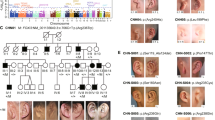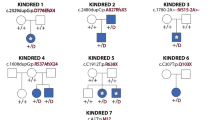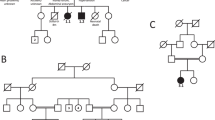Abstract
WLS (Wnt ligand secretion mediator or Wntless) orchestrates the secretion of all Wnt proteins, a family of evolutionary conserved proteins, involved in Wnt signaling pathway that has many essential biological functions including the regulation of development, cell proliferation, migration and apoptosis. Biallelic variants in WLS have recently been described in 10 patients with pleiotropic multiple congenital anomalies (MCA) known as Zaki syndrome. We identified a likely disease-causing variant in WLS (c.1579G>A, p.Gly527Arg) in a boy presented with a broad range of MCA including microcephaly, facial dysmorphism, alopecia, ophthalmologic anomalies, and complete soft tissue syndactyly. These features were reminiscent of Zaki syndrome although variable clinical severity was observed. In a detailed clinical assessment, our patient also displayed microphthalmia, dental anomalies, skeletal dysplasia with spontaneous fractures and Dandy-Walker malformation. As such, we extend the phenotype linked to Zaki syndrome. This study further highlights the importance of a thorough clinical evaluation to delineate the phenotypic spectrum associated with WLS variants and suggests that genotype-phenotype correlations due to variant localization seems likely. However, future work on additional patients and more functional studies may give further insights into genotype-phenotype correlations and the complex function of WLS.
This is a preview of subscription content, access via your institution
Access options
Subscribe to this journal
Receive 12 print issues and online access
$259.00 per year
only $21.58 per issue
Buy this article
- Purchase on Springer Link
- Instant access to full article PDF
Prices may be subject to local taxes which are calculated during checkout




Similar content being viewed by others
Data availability
The data that support the findings of this study are available from the corresponding authors upon reasonable request.
References
Das S, Yu S, Sakamori R, Stypulkowski E, Gao N. Wntless in Wnt secretion: molecular, cellular and genetic aspects. Front Biol (Beijing). 2012;7:587–93.
Bartscherer K, Pelte N, Ingelfinger D, Boutros M. Secretion of Wnt ligands requires Evi, a conserved transmembrane protein. Cell. 2006;125:523–33.
Banziger C, Soldini D, Schutt C, Zipperlen P, Hausmann G, Basler K. Wntless, a conserved membrane protein dedicated to the secretion of Wnt proteins from signaling cells. Cell 2006;125:509–22.
Nygaard R, Yu J, Kim J, Ross DR, Parisi G, Clarke OB, et al. Structural basis of WLS/Evi-mediated Wnt transport and secretion. Cell 2021;184:194.e14–206.e14.
Yu J, Chia J, Canning CA, Jones CM, Bard FA, Virshup DM. WLS retrograde transport to the endoplasmic reticulum during Wnt secretion. Dev Cell. 2014;29:277–91.
Chai G, Szenker-Ravi E, Chung C, Li Z, Wang L, Khatoo M, et al. A Human Pleiotropic Multiorgan Condition Caused by Deficient Wnt Secretion. N Engl J Med. 2021;385:1292–301.
van Amerongen R, Berns A. Knockout mouse models to studyWnt signal transduction. Trends Genet. 2006;22:678–89.
Ikeya M, Lee S, Johnson J, McMahon A, Takada S. Wntsignalling required for expansion of neural crest and CNS pro-genitors. Nature 1997;389:966–70.
Preising MN, Görg B, Friedburg C, Qvartskhava N, Budde BS, Bonus M, et al. Biallelic mutation of human SLC6A6 encoding the taurine transporter TAUT is linked to early retinal degeneration. FASEB J 2019;33:11507–27. https://doi.org/10.1096/fj.201900914RR.
McMahon AP, Bradley A. The Wnt-1 (int-1) proto-oncogene is required for development of a large region of the mouse brain. Cell 1990;62:1073–85.
Rowitch DH, Danielian PS, McMahon AP, Zec N. Cystic malformation of the posterior cerebellar vermis transgenic mice that ectopically express engrailed-1, a homeodomain transcription factor. Teratology 1990;60:22–8.
Cavodeassi F, Carreira-Barbosa F, Young RM, Concha ML, Allende ML, Houart C, et al. Early stages of zebrafish eye formation require the coordinated activity of Wnt11, Fz5, and the Wnt/beta-catenin pathway. Neuron 2005;47:43–56.
Liu C, Bakeri H, Li T, Swaroop A. Regulation of retinal progenitor expansion by Frizzled receptors: implications for microphthalmia and retinal coloboma. Hum Mol Genet. 2012;21:1848–60.
Liu C, Widen SA, Williamson KA, Ratnapriya R, Gerth-Kahlert C, Rainger J, et al. A secreted WNT-ligand-binding domain of FZD5 generated by a frameshift mutation causes autosomal dominant coloboma. Hum Mol Genet. 2016;25:1382–91.
Hagglund AC, Berghard A, Carlsson L. Canonical Wnt/beta-catenin signalling is essential for optic cup formation. PLoS ONE. 2013;8:e81158.
Lieven O, Ruther U. The Dkk1 dose is critical for eye development. Dev Biol. 2011;355:124–37.
Veien ES, Rosenthal JS, Kruse-Bend RC, Chien CB, Dorsky RI. Canonical Wnt signaling is required for the maintenance of dorsal retinal identity. Development. 2008;135:4101–11.
Joeng KS, Lee YC, Jiang MM, Bertin TK, Chen Y, Abraham AM, et al. The swaying mouse as a model of osteogenesis imperfect caused by WNT1 mutations. Hum Mol Genet. 2014;23:4035–42.
Keupp K, Beleggia F, Kayserili H, Barnes AM, Steiner M, Semler O, et al. Mutations in WNT1 cause different forms of bone fragility. Am J Hum Genet. 2013;92:565–74.
Tamura M, Nemoto E. Role of the Wnt signaling molecules in the tooth. Jpn Dent Sci Rev. 2016;52:75–83.
Gowans GJ, Bridgers JB, Zhang J, Dronamraju R, Burnetti A, King DA, et al. Recognition of histone crotonylation by Taf14 links metabolic state to gene expression. Mol Cell 2019;76:909–21.
Acknowledgements
We are indebted to the family who participated in this study. HJB was supported by grants from PRO RETINA Deutschland, Stiftung Auge (Deutsche Ophthalmologische Gesellschaft; HJB), Dr. Senckenbergische Stiftung and Köln Fortune (University Hospital of Cologne).
Author information
Authors and Affiliations
Contributions
GA-S, HA, and HB designed and supervised the study. GA-S, HA, GEl-K, MT were actively involved in clinical evaluation and follow-up of the patient and interpreted the brain MRI. MA-H involved in Sanger sequencing. NA performed the oro-dental examination. HB, HT, PN conducted next-generation sequencing and data analysis and interpretation. The first draft of the paper was written by GA-S. All authors had critically reviewed the paper and approved the final version.
Corresponding author
Ethics declarations
Competing interests
The authors declare no competing interests.
Additional information
Publisher’s note Springer Nature remains neutral with regard to jurisdictional claims in published maps and institutional affiliations.
Supplementary information
Rights and permissions
Springer Nature or its licensor (e.g. a society or other partner) holds exclusive rights to this article under a publishing agreement with the author(s) or other rightsholder(s); author self-archiving of the accepted manuscript version of this article is solely governed by the terms of such publishing agreement and applicable law.
About this article
Cite this article
Abdel-Salam, G.M.H., Afifi, H.H., Abdel-Hamid, M.S. et al. Expanding the phenotypic spectrum and clinical severity associated with WLS gene. J Hum Genet 68, 607–613 (2023). https://doi.org/10.1038/s10038-023-01152-2
Received:
Revised:
Accepted:
Published:
Issue Date:
DOI: https://doi.org/10.1038/s10038-023-01152-2



